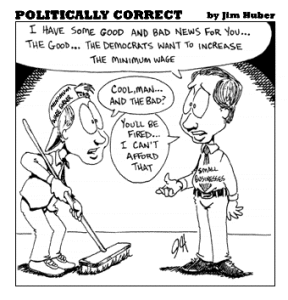 Minnesota Governor Mark Dayton signed legislation this month that will gradually boost the state’s minimum wage to $9.50 by 2016. Passed with only Democratic support in the state legislature, the new law shall mandate that Minnesota’s current minimum wage of $6.15 per hour, one of the lowest in the country, will rise by more than $3 over the next few years and stay tied to inflation.
Minnesota Governor Mark Dayton signed legislation this month that will gradually boost the state’s minimum wage to $9.50 by 2016. Passed with only Democratic support in the state legislature, the new law shall mandate that Minnesota’s current minimum wage of $6.15 per hour, one of the lowest in the country, will rise by more than $3 over the next few years and stay tied to inflation.
Supporters are delighted that this bill shall help the middle and lower class earn more money per hour at a rate higher than the current federal minimum wage of $7.25 per hour.
Though lower than President Obama’s proposed $10.10 per hour rate as mentioned in his most recent State of the Union Address, it is irrefutable that this increase is a milestone victory for the advocates of livable wages. Based upon the worth of the American dollar due to inflation, the $9.50 rate is comparable to the rate in 1968 where $1.60 per hour was worth approximately $10.00 today.
Critics and opponents of the bill, most vocally those of the conservative and Republican sect, have argued that this bill shall be detrimental to small businesses and hurt a still recovering economy. Additionally, the argument has been made that due to a higher cost for workers’ wages, fewer jobs will be available thereby raising the unemployment rate. While these arguments against the bill may appear logical at a first glance, there are several considerations to take which may dissuade that opinion.

Primarily, one must consider the inequality of wealth in the United States. From 1979 to 2007, the income of the wealthiest percent of Americans has risen 281 percent. For the top fifth, income has increased 95 percent. The rate is 25 percent for the middle fifth, and the bottom fifth has seen a paltry rise of 16 percent in income. The top 20 percent wealthiest in the nation own 93 percent of the nation’s wealth, the top 1 percent own 50.9 percent of stock, and since 1978, the average CEO has had their salary grow one hundred and seventy times faster than the typical worker’s salary. Ladies and gentlemen, this is not a debate over opinions; it is a debate over facts.
The American Dream, at the most basic level, is the belief that by working hard and fairly, one can hope for a better future for their prosperity. By putting up with the difficulties of today, we are conformed to believe that things will be better and the natural curve of humanity leans toward moral equality and opportunity.
However, by creating an ever-increasing gap between the most and least wealthy, we ripen the conditions for despair and conflict amongst ourselves in this nation. A system cannot exist in which the “elite” grow ever more privileged and the “bottom” must fend for themselves like animals. Capitalism has been viewed in America as a shining example of free marketing where anyone can prosper. In reality, the rich become richer and the poor become poorer should it remain unchecked.
Critics shall speak of trickle down economics. Should the rich gain even more money, some of that wealth will eventually make its way down the social ladder to the less fortunate.
While this ideology of throwing the dog a bone paints an optimistic picture of human character, wealth inequality has been proven to be a terrible threat to economic security both during the Great Depression and the Financial Crisis of 2008, the latter of which has lead to us being situated in a state of economic recovery. Trickle down economics has always proven to be a false belief in the moral good of the wealthy.
Corporations and businesses shall always require workers, people will always require a set amount of money to make ends met, and this country shall always at its core lean toward the belief of the American Dream. Fights and revolutions have at times been necessary, countless individuals and groups have impended on the natural curve of progress and there will always be those who will attempt to paint a pretty picture through sugar coated words as they attempt to take advantage of the less fortunate. However, America has proven to be resilient toward adversity.
The right course of action does eventually emerge, despite the impending roadblocks making it slower than we’d ideally desire. Money is a tool every individual requires in this capitalistic, consumer society. If we want to give everyone a fair shot, we have to give everyone, especially the poorest, the means to survive in the world we live in.